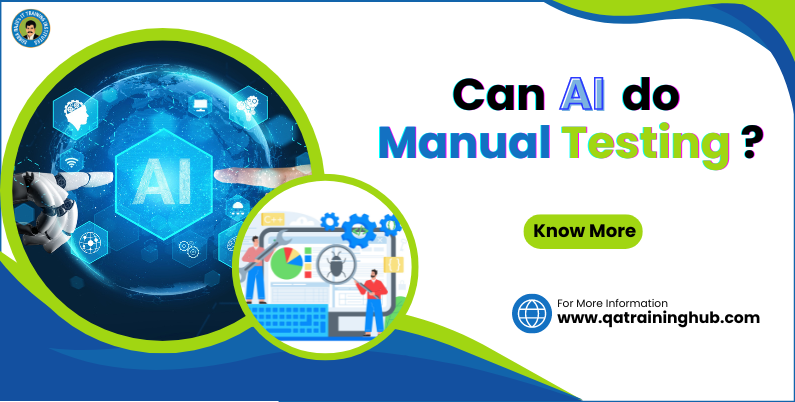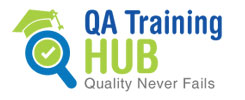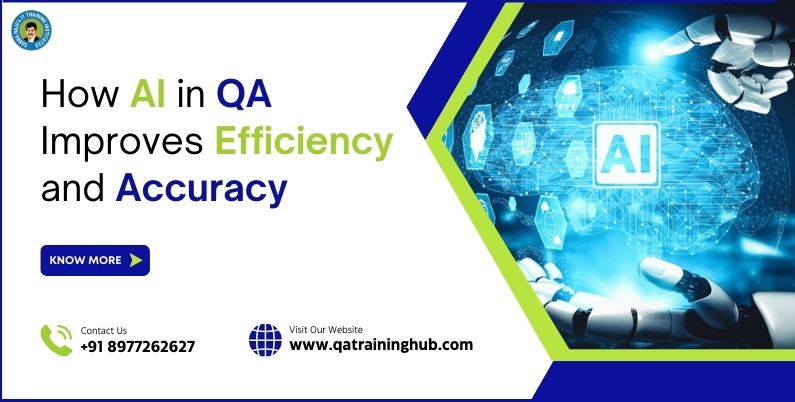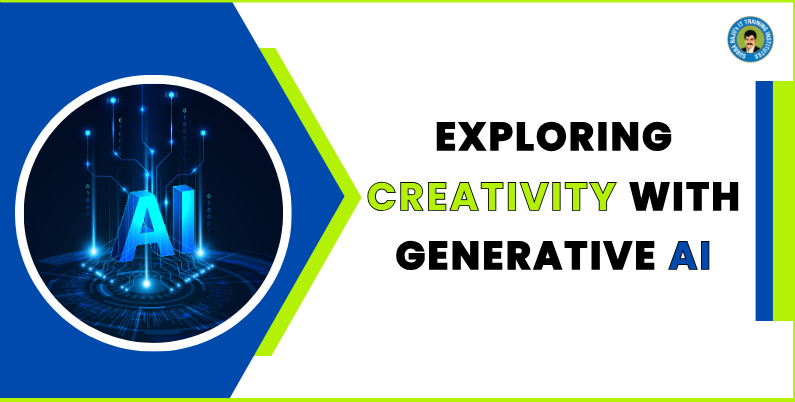
Can AI Do Manual Testing? Exploring the Intersection of Human Expertise and Artificial Intelligence in Software Testing
In the Software development, testing remains a crucial phase to ensure the quality, reliability, and usability of applications. Traditionally, manual testing, conducted by human testers, has been fundamental to quality assurance processes. However, with the rise of artificial intelligence (AI) and its rapid advancement, there is a growing interest in exploring whether AI can effectively replace human testers in manual testing tasks. This article investigates the question: Can AI do manual testing? We’ll discuss the capabilities of AI in the software testing, its current limitations, and the potential implications for the future of quality assurance in software development.
Understanding Manual Testing:
Manual testing is a process where testers execute test cases manually without the use of automation tools. It requires carefully examining software features to identify bugs, defects, and problems. Human testers simulate end-user behaviour, interacting with the software interface to validate its performance, usability, and functionality across different scenarios. While manual testing offers a comprehensive approach to detecting defects, it is often time-consuming, requires a lot of effort, and is prone to human error.
Challenges in Manual Testing:
Manual testing, while essential, presents several challenges, including:
Time-consuming: Executing test cases manually can be time-consuming, especially for large-scale applications with complex functionalities.
Resource-intensive: Employing a team of human testers requires considerable resources in terms of time, manpower, and costs.
Subjectivity: Human testers may exhibit biases or overlook certain aspects of testing, which could result in potential gaps in quality assurance efforts.
Scalability: Expanding manual testing to handle frequent updates or changes in software can become burdensome and ineffective.
AI in Manual Testing:
Artificial intelligence, with its capacity to analyse vast amounts of data, detect patterns, and make decisions, offers potential for automating different parts of manual testing. AI-powered testing tools and techniques seek to enhance human testers’ abilities, simplify testing processes, and improve the overall efficiency and effectiveness of quality assurance efforts.
Here are some ways AI is being integrated into manual testing:
Test Case Generation: AI algorithms can analyse software requirements and specifications to automatically generate test cases, covering various use cases and scenarios. By utilizing techniques such as machine learning and natural language processing, AI can identify potential edge cases and corner scenarios that might be missed by human testers.
Test Execution Assistance: While AI itself doesn’t perform manual testing, it can provide tools and frameworks to assist testers during test execution. For example, AI-powered testing platforms may offer features such as intelligent test case management, test execution tracking, and analysing results to make manual testing processes more efficient..
Defect Detection: AI algorithms can analyse application logs, user feedback, and test results to identify anomalies, patterns of errors, and potential defects. By utilizing anomaly detection and pattern recognition techniques, AI can identify sections of the application that need additional examination or debugging, leading to quicker resolution of problems.
Test Prioritization: AI-driven analytics can prioritize test cases based on factors such as risk, code changes, and business impact. This helps testers focus their efforts on the most critical areas during manual testing, optimizing resource allocation and testing coverage.
User Experience Testing: AI-driven testing tools can analyse user interactions, feedback, and behaviour to assess the application’s usability, accessibility, and overall user experience. By simulating real users in various situations, AI can offer valuable insights into how the application performs for its target audience, helping developers to make data-driven improvements.
Limitations of AI in Manual Testing:
Although AI has great potential to transform manual testing, it’s crucial to recognize its current limitations:
Lack of Contextual Understanding: AI algorithms may struggle to understand the broader context of the application, which includes specific details related to its domain, business logic, and user expectations. Human testers offer domain knowledge and contextual understanding that is challenging to replicate with AI alone.
Dependency on Training Data: AI models depend on training data to understand patterns and make predictions. If the training data is biased, incomplete, or doesn’t accurately represent real-world situations, AI might generate inaccurate or unreliable outcomes.
Difficulty in Handling Unpredictable Scenarios: AI algorithms may struggle to handle unpredictable scenarios or unique scenarios that diverge significantly from the training data. Human testers excel at adaptability and creativity, enabling them to handle complex situations that AI may find challenging.
Inability to Replace Human Judgment: While AI can automate repetitive tasks and help with decision-making, it cannot replace human judgment and creativity. Certain aspects of testing, such as exploratory testing and usability evaluation, need human testers’ thinking skills and knowledge about the subject.
Ethical and Privacy Concerns: AI-powered testing tools may raise concerns regarding data privacy, security, and ethical implications. As AI algorithms analyse sensitive user data and make decisions that impact software quality, it’s essential to address ethical considerations and ensure transparency and accountability in testing practices.
The Future of Manual Testing with AI:
Despite its current limitations, AI has a lot of potential to change how manual testing works in the future. As AI gets better and grows up, we can expect the following developments:
Hybrid Testing Approaches: The future of manual testing may involve hybrid approaches that combine the strengths of both human testers and AI-powered tools. Human testers will focus on high-level test planning, strategy formulation, and complex exploratory testing, while AI automates repeated tasks and provides intelligent insights to improve testing efficiency.
Continuous Learning and Adaptation: AI algorithms will get better at learning from feedback, adjusting to different needs, and getting better as time goes on. By using methods like reinforcement learning and learning without supervision, testing tools powered by AI will become more able to work on their own and change to handle new testing problems.
Explainable AI in Testing: To address concerns regarding AI’s lack of transparency and interpretability, efforts will be made to develop explainable AI techniques that provide insights into how AI algorithms make decisions in testing. By improving transparency and accountability, explainable AI will build trust and confidence in AI-powered testing practices.
AI-driven Quality Insights: Analytics dashboards and quality metrics powered by AI will give stakeholders useful information about the quality of software, areas of risk, and chances to make things better. By bringing together and showing data from different places, AI-driven quality insights will enable informed decision-making and continuous improvement in software development processes.
Ethical AI Testing Practices: As AI becomes more involved in testing, organizations will focus more on ethical considerations and responsible AI practices. This includes ensuring data privacy and security, as well as preventing bias and discrimination. Following these ethical practices in AI testing is crucial for building trust and confidence in AI-powered testing tools and techniques.
Conclusion:
The intersection of human skills and artificial intelligence in manual testing presents both opportunities and challenges for the future of software quality assurance. While AI offers potential for automating repetitive tasks, improving testing efficiency, and providing intelligent insights, it cannot replace human testers’ thinking abilities, knowledge, and imagination. As organizations adopt AI-powered testing tools and techniques, it’s essential to strike a balance between automation and human judgment, build collaboration between human testers and AI systems, and prioritize ethical considerations and responsible AI practices.
QA Training Hub is dedicated to offering advanced training and resources that help testers develop the skills and knowledge required to succeed in an environment where AI plays a significant role in testing and tells about how can AI do manual testing. From mastering AI-powered testing tools to cultivating critical thinking and problem-solving skills, our comprehensive training programs equip testers with the expertise to excel in today’s dynamic software industry.
Join QA Training Hub today and learn how can AI do manual testing and start exploring the power of AI in manual testing. Together, let’s shape the future of software quality assurance.







